Module 6: Chain Saw Use and Safety
Lesson One - Safety Equipment and Clothing
INTRODUCTION
The chainsaw is no longer the exclusive equipment of professional forest workers. It is commonly used by woodlot owners and casual users. Consequently, there has been an increase in the number of chainsaw injuries. Most injuries result from the lack of knowledge, skill, judgment. Adequate training for both the casual and professional user is the key to safe use.
Before we discuss the various cutting techniques, it is essential that you read and fully understand the following section on safety equipment and clothing.
THE SAFETY-EQUIPPED SAW
Although modern chainsaws are similar in basic design, some lack essential safety features. Make sure your saw is equipped with the following:
 Throttle control lockout
Throttle control lockout
Prevents accidental acceleration of the saw. The lockout must be depressed before the throttle can be activated.
Chain brake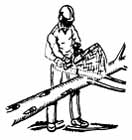
By stopping the chain in a fraction of a second, the chain brake can help avert possible injury from kickback. (Kickback is discussed in Lesson 2 )
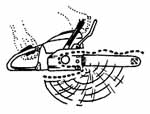
Chain catcher
Reduces the distance a broken or dislodged chain will whip back towards the operator.
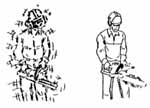 Anti-vibration system
Anti-vibration system
Protects the operator from the effect of saw vibration which can lead to loss of sensitivity in the fingers and possible circulatory disorders.
 Rear handguard
Rear handguard
Protects the right hand from a broken or dislodged chain.
Safety chain![]()
Protective guard links or sloping depth gauges in a safety chain reduce the risk of kickback.
Safety guide bar
The four guide bars are described below:
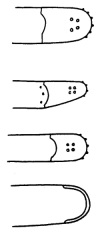 Sprocket nose:
Sprocket nose:
Conventional guide bar permitting tighter chain, less heat from friction and reduced chain wear.
Guard Tip: Same features as sprocket nose but with greatly reduced kickback zone therefore safer. However, the bar cannot be rotated to promote even wear and longer life.
Slim Line: Entire bar is narrow thus reducing bar tip radius and kickback zone. Most recommended type.
Hardnose: NOT recommended because of large kickback zone, looser chain, increased friction at nose and decreased chain life.
PERSONAL PROTECTIVE EQUIPMENT
Select work clothes on the basis of safety, protection and comfort. Clothes should be comfortable but never loose to interfere with the safe use of the saw. The material should be light, strong, capable of keeping you dry and warm as well as allowing excess heat and moisture to escape.
Many synthetic fabrics, cotton and wool products are available but rarely will they meet all your requirements. It is necessary to mix and match clothing for best results. Using a chainsaw is hard work. Therefore, wear layers of clothing that can be removed one at a time to control your body heat. This is very important during colder months.
 Head
Head
A hardhat must be worn to protect your head from falling limbs, dead stubs or other hazards. It should be light, comfortable and a highly visible color (e.g. orange, yellow, or bright red). A Canadian Standards Association (CSA) approved hardhat is recommended. The shell and suspension should be checked for any visible damage before each use. Discard any hardhat that is cracked, dented, or cut. Replace the suspension if it has torn or broken threads. Never put insect repellent, paint or oil on your hard hat or drill holes in the shell. These changes will weaken the shell and reduce the protection it provides. Never leave it on the rear window shelf of a vehicle. Intense sunlight will affect its protective quality.
 Eyes
Eyes
Eye protection is essential to guard against injuries from branches and flying particle. The most common protective is a safety mesh visor made of nylon or metal. The visor will prevent eye damage and allow you to keep your work in full view. Safety goggles or safety glasses are acceptable alternatives. If you choose safety glasses, select the type with wrap-around lenses, or side shields.
 Ears
Ears
The noise produced by a chainsaw is above 85 decibels and will cause permanent damage to your hearing. Even the newer saws that are much quieter may injure your hearing with constant exposure. It is necessary to wear earmuffs or ear plugs to reduce the noise level. Earmuffs also protect the external ear. Clean the soft plastic pads and foam inserts periodically with soap and water. Always replace them before they become old and brittle.
 Hands
Hands
Chainsaw gloves or mitts are worn to protect hands from injury and for warmth. Some forest workers wear gloves with added safety padding on the back of the left hand. Some prefer mittens with a separate index finger to operate the throttle. Gloves are not required safety equipment in Nova Scotia.
Legs
Since many chainsaw accidents cause injury to legs, you must wear protection. Three types of protection include:
![]() Safety pants: Provide the best protection. They have cut-resistant ballistic nylon sewn into the whole front of the pants. The protected area should be from the bottom of the heel (while in a standing position) to below the waistband. Newer styles also have ballistic nylon sewn into the lower back section of the legs.
Safety pants: Provide the best protection. They have cut-resistant ballistic nylon sewn into the whole front of the pants. The protected area should be from the bottom of the heel (while in a standing position) to below the waistband. Newer styles also have ballistic nylon sewn into the lower back section of the legs.
Chaps: Cut-resistant ballistic nylon leg pads that strap over work pants.
Safety pads: Cut-resistant ballistic nylon pads that fit into pockets inside pant legs or are sewn in. Generally they give good protection but sometimes they unhook and slump in the pocket leaving the legs unprotected.
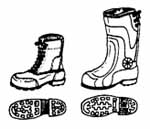 Feet
Feet
Wear boots with CSA Class A steel toe caps and non slip soles. Many forest workers prefer boots which feature ballistic nylon protection in the front similar to safety pants or chaps. Work boots also protect the foot from painful crushing injuries.
*******
REMEMBER a chainsaw is not a toy! It can seriously injure or even kill. NEVER use your saw without wearing all your personal protective clothing. NEVER use a saw that is not equipped wit all safety features.
